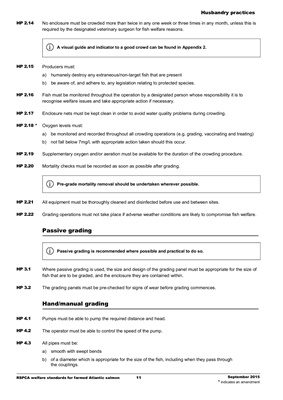
Husbandry practices
RSPCA welfare standards for farmed Atlantic salmon 11 September 2015
* indicates an amendment
HP 2.14 No enclosure must be crowded more than twice in any one week or three times in any month, unless this is
required by the designated veterinary surgeon for fish welfare reasons.
A visual guide and indicator to a good crowd can be found in Appendix 2.
HP 2.15 Producers must:
a) humanely destroy any extraneous/non-target fish that are present
b) be aware of, and adhere to, any legislation relating to protected species.
HP 2.16 Fish must be monitored throughout the operation by a designated person whose responsibility it is to
recognise welfare issues and take appropriate action if necessary.
HP 2.17 Enclosure nets must be kept clean in order to avoid water quality problems during crowding.
HP 2.18 * Oxygen levels must:
a) be monitored and recorded throughout all crowding operations (e.g. grading, vaccinating and treating)
b) not fall below 7mg/l, with appropriate action taken should this occur.
HP 2.19 Supplementary oxygen and/or aeration must be available for the duration of the crowding procedure.
HP 2.20 Mortality checks must be recorded as soon as possible after grading.
Pre-grade mortality removal should be undertaken wherever possible.
HP 2.21 All equipment must be thoroughly cleaned and disinfected before use and between sites.
HP 2.22 Grading operations must not take place if adverse weather conditions are likely to compromise fish welfare.
Passive grading
Passive grading is recommended where possible and practical to do so.
HP 3.1 Where passive grading is used, the size and design of the grading panel must be appropriate for the size of
fish that are to be graded, and the enclosure they are contained within.
HP 3.2 The grading panels must be pre-checked for signs of wear before grading commences.
Hand/manual grading
HP 4.1 Pumps must be able to pump the required distance and head.
HP 4.2 The operator must be able to control the speed of the pump.
HP 4.3 All pipes must be:
a) smooth with swept bends
b) of a diameter which is appropriate for the size of the fish, including when they pass through
the couplings.
i
i
i